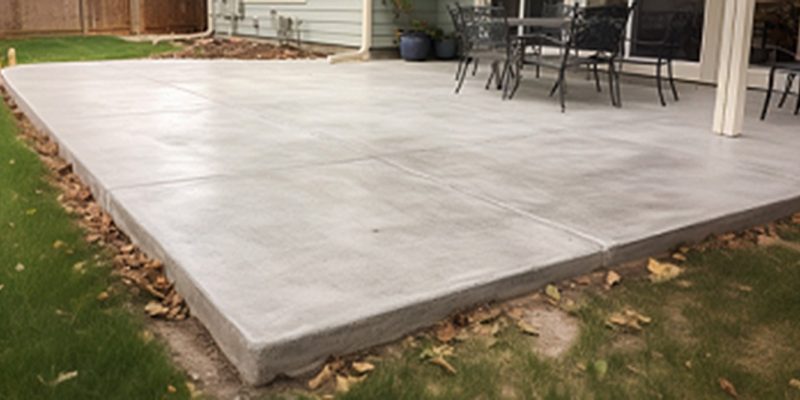A well-sized patio isn’t just a luxury; it’s an investment in your home’s comfort and style. Discovering the perfect size involves thoughtful planning. Let’s delve into the crucial considerations for tailoring a patio that seamlessly fits into your Des Moines lifestyle.
Designing an outdoor patio space tailored to your lifestyle provides countless benefits, from entertainment to relaxation. However, determining the optimal size involves assessing backyard space, planned uses, weather, codes, and costs to create a balanced area meeting your needs.
Understanding Your Space
Understanding your yard’s dimensions is the first step. Measure the available space accurately, considering the entire yard to unlock the full potential of your outdoor haven.
When deciding your patio’s dimensions, first examine what usable yard area exists. Consider existing landscaping, drainage, utilities, and any sections too narrow or irregular to pave. Budget at least a 3-foot buffer between the patio and house. Be aware that shapes impact perceived spaciousness – squares feel more open than long rectangles.
For mid-size backyards of 30 by 40 feet, target a 288 to 400 square foot patio accommodating separate conversation, dining, and grill zones.
In spacious yards, go up to 500-600 square feet to host gatherings more comfortably without dwarfing the area.
For petite urban plots or townhomes, scale down to a cozy 150 square foot bistro setup.
TIP
Position the patio where it best suits natural traffic flow from indoor living areas to lawn or gardens. Check sun exposure at different day parts – you may angle the patio to follow shade patterns.
Purpose and Activities
Carefully define your patio’s primary purpose before determining dimensions. Will it mainly serve as an al fresco dining space or summer hangout for relaxation? Do you plan to install a full outdoor kitchen for entertaining? Understanding key goals helps tailor the right square footage and features.
Tailor the size to your envisioned activities. From intimate family gatherings to hosting events, your patio’s size should harmonize with your planned functions.
For dining, allow ample clearance around furniture – plan for at least two to three feet between table edges, fire pits, and other elements.
If incorporating a grill or kitchen, ensure enough room for safe traffic flow when cooking is underway. For conversation areas, make groupings small enough to enable effortless interaction without yelling.
TIP
During Des Moines’ prime weather months, consider projecting movies or TV against a blank fence using an inflatable screen, dictating enough space to set up comfortable seating at safe viewing distances.
Furniture and Layout Planning
Optimize your space with smart furniture choices. Learn how to select pieces that complement your design, provide comfort, and make the most of your available square footage.
Measure your current patio furniture’s footprint or use templates to experiment with scale models before installation. This prevents discovering items overwhelm or get lost on a finished patio. While furnished look is appealing, too much furniture cramping the space inhibits fluid movement – pare down pieces to the essentials.
A well-thought-out layout is more than aesthetics. Discover the importance of functional arrangements that enhance usability while adding an appealing touch. Sketch possible layouts marking pathways and activity hubs on graph paper. Avoid narrow routes hampering navigation. Frame different zones using borders like planters, decorative walls, tile insets or overhead beams.
Employ elevated platforms for hot tubs or gazebo seating nooks to delineate unique spots without demanding more square footage. Vary paver colors, materials and patterns to make zones pop. Keep sightlines open to views beyond the property where possible. Most importantly, ensure the layout promotes seamless flow between areas with no awkward barriers or bottlenecks.
Climate Factors
Des Moines endures cold snowy winters yet steaming hot summers – maximize usability by planning adjustable features to moderate conditions during peak months. Control sunlight and rainfall using retractable awning systems – side shades prevent brutal late day summer glare while allowing winter solar warmth. Strategically positioned umbrella tables shelter spring showers but fold away come fall.
Embrace the changing seasons by incorporating flexibility into your patio’s design. From retractable covers to versatile furnishings, make adjustments a breeze.
Wind protection is essential – construct decorative fence partitions, trellises and perimeter plant buffers to create barriers against gusts. Portable space heaters extend cooler evening enjoyment while misting systems provide hot weather relief when entertaining. Employ durable all-weather wicker, teak or aluminum furniture over delicate pieces requiring storage. Washable performance fabrics withstand spills better than cotton cushions.
For surfacing, select freeze-thaw resistant concrete, stone or composite decking. Where possible, keep 30-50% of the area as permeable materials like pea gravel or permeable paver grids to avoid flooding during sudden deluges. Install drainage channels along the periphery.
Local Regulations and Permits
In Des Moines, a permit is required to construct a new or expand an existing patio over 120 square feet on residential property. The city also enforces zoning restrictions and stormwater management rules you must adhere to. Consider setback regulations limiting how close hardscaping can be installed near property lines or public pathways. Development codes also govern permitted patio coverage as a percentage of total backyard ground area, which varies by zoning classification.
Additionally, HOAs may impose community rules or architectural oversight on exterior changes. Carefully investigate all applicable statutes for your neighborhood and project type during the planning phase – altering designs late can exponentially boost costs. Being informed upfront streamlines work coordination and prevents violations resulting in fines down the road.
Cost Considerations
Patio expenses escalate rapidly with greater dimensions. On average, you can expect to invest $15-$25 per square foot for professional installation of a basic concrete slab, going up to $50 per square foot for high-end finishes like decorative stone, tile or brick. Complex layouts also drive up pricing. However, thoughtfully limiting size from the outset keeps budgets contained without sacrificing everyday enjoyment.
Utilize Your Space
For affordability, use irregular spaces efficiently – a kidney bean shape envelops more area than a square using the same perimeter dimensions. Extend the house’s roofline to cover a portion rather than building a separate pergola. Employ precast concrete blocks or gravel for non-critical zones like detached fire pits. Phase larger projects to spread costs over years as needs expand.
DIY construction with freestanding deck blocks or bonding concrete pavers on sand base slashes expenses for handy homeowners. Just ensure you have enough expertise to meet code. Consider negotiating with multiple landscape vendors – many offer creative solutions to balance cost with value using mixed media like concrete pads with inset aggregate borders. Careful planning and creative framing of budgets yields the highest return on investment.
Conclusion
Designing a patio fully poised to meet your household’s needs requires weighing numerous spatial, functional and behavioral considerations before finalizing dimensions. Following the guidance above will lead you to the perfect-sized outdoor oasis your Des Moines property deserves.

